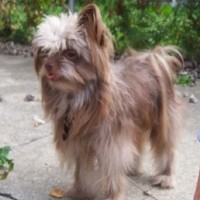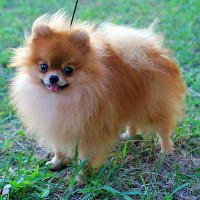Appearance of the Brusselranian
|
| Due to the wide range of colors that parent breeds can enter, this particular hybrid breed can vary considerably in appearance. As a general rule, the Brusselranian is a small dog with a long, wiry coat that can come in many colors such as black, gray, red, orange and tan with white accents. The squashed monkey face of the Brussels Griffon seems to be a defining characteristic of the Brusselranian and is usually associated with the puffy coat of the Spitz Toy / Pomeranian. Large dark eyes hold much intelligence and mischief, while folded ears frame the face, ending just below the eye line. Although the coat is low-maintenance, it is rough to the touch and tends to peel off seasonally. Grooming will be important to ensure that no knots or tangles are created in the coat and to minimize shedding. Because this breed has a thicker coat, colder climates will prevent them from overheating too quickly. |
Temperament of the Brusselranian
|
| The Brusselranian takes on the temperament of its two parent breeds in the most excellent way. This little companion dog is quick-witted, loyal, adorable, fun-loving, cheerful and loves to cuddle. He's easy to train and can be quite independent, so he can be safely left at home for a short time if need be. Because the Spitz Toy / Pomeranian can be a little cheerful, the Brusselranian may tend to bark when excited, but he won't talk about it very loudly. This is an ideal dog for apartments or small homes and families who may have children. Just bear in mind that older children may enjoy this dog more, as younger people can irritate the dog with too much handling. The Brusselranian is non-aggressive and enjoys spending time with its family, making it an excellent companion dog for all kinds of living situations. |
Needs and activities of the Brusselranian
|
| Because the Brusselranian has fairly energetic parents, it will need a moderate amount of exercise every day. Activities such as a long walk, playing in the yard, chasing toys around the house, tug-of-war and working out are excellent ways to tire out your little friend. A few times a day of this kind of play will be enough to keep your Brusselranian well-behaved and happy. Early training and socialization are very important when it comes to training your dog, as this will ensure that the Brusselranian knows how to behave with other animals and people, and will provide him with a means of releasing productive energy. This breed is fairly easy to train, and training sessions are both physically and mentally stimulating. Despite their cheerful energy, Brusselranians will do well in any size of home and prefer a slightly cooler climate, as their fur is rather thick. If it's too hot or cold outside for outdoor activities, you can always wear your Brusselranian with short periods of play in the house. |
Maintenance of the Brusselranian
|
| Although the Brusselranian doesn't require as careful grooming as the Spitz Toy / Pomeranian, it will still shed often due to the fact that both parent breeds shed seasonally. To take good care of your Brusselranian and minimize shedding, it's a good idea to brush him a few times a week with a metal comb and wire brush. Bathing should only be done occasionally, or when your dog becomes particularly dirty after a period of play. Because this breed folds over its ears, it's very important to dry the ears completely after bathing or swimming. This will prevent any additional moisture from becoming trapped inside the ear, leading to infection and inflammation. In addition to brushing and bathing, be sure to trim your dog's nails every few weeks or when you hear the nails tapping against the floor. This will keep the feet in perfect working order and good health. |









 English (United Kingdom)
English (United Kingdom)